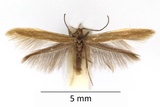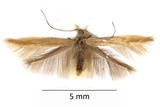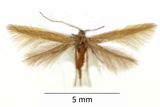Coleophora caespititiella Zeller, 1839 Species
Last modified: Nov. 27, 2025, 7:50 p.m.
A not-so-common and local species in Belgium, that can, however, occur very abundantly at certain localities.
Details
- Classification
- Family: Coleophoridae > Genus: Coleophora > Species: Coleophora caespititiella
- Vernacular names
- Bieskokermot (NL), Buff rush case-bearer (EN), Große Binsen-Sackmotte (DE)
- Synonyms
- Coleophora agrammella Wood, 1892
- First mention in Belgium
- De Fré Ch. 1858. Catalogue des Microlépidoptères de la Belgique. — Annales de la Société entomologique belge 2: 45–162. On page 144 (as C.[oleophora] Caespititiella. Zell.). view page
- Status
-
Native
Distribution
Case
The tri-valved case of this species is small measuring 4–5 mm and is often covered with small black droppings from the caterpillar. Occasionally there are also faint light longitudinal streaks.
The mouth angle is 10°–44°.
See also bladmineerders.be.
Bionomics
The eggs are deposited on the flowers of the hostplant. Juvenile larvae live, without forming a case, inside a seed granule, feeding on it. Only when the larvae almost reach maturity, a small case is constructed. The latter is difficult to find between the seed heads but the best period is September. The caterpillars are full-grown in October, they mostly leave the hostplant and hibernate at ground level. Only occasionally they stay hidden between the seeds. Next spring, the pupation takes place inside the case.
C. caespititiella is significantly less often observed than other Juncus-feeders because of the more hidden lifestyle.
Flight periods
The adults fly in May and June. Rarely, some specimens have been observed well into October.
Observed on
- Host plant (species):
- Juncus subuliflorus, Juncus effusus, Juncus articulatus and Juncus inflexus
This species is restricted to plants of the genus Juncus.











